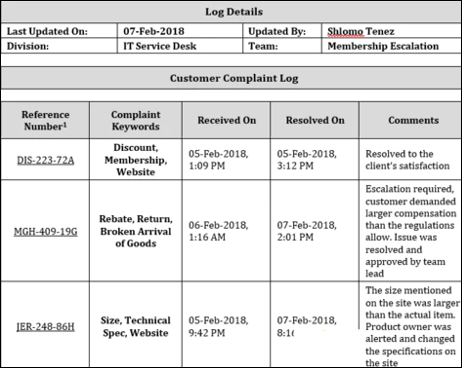
Maintaining a complaint log is vital for an organization that wants to learn from its mistakes, and refrain from reinventing the wheel each time it encounters a known (but forgotten) incident. A customer complaint log records all of the past complaints made by the external and internal regarding any incidents which have to do with the organization's IT services.

This type of log can be used as a database for the service desk employees, whenever they encounter an incident for the first time. Putting effort into a log like this may seem like a waste of time at first, but once it saves the service desk time and effort (and money for the organization) they will see the benefit of it. This means that they need to detail each and every incident they encounter and tag each one with the correct words.
The template consists of the following information - Which team owns it and uses it (Division > Team), who updated it last and when it was last updated.
The reference number of the complaint record, which is a unique reference number. If the log is on a shared folder or SharePoint site, then clicking on the number will open up the full complaint record thus allowing the service desk to review the entire complaint from start to finish
The keywords of the complaint, which is basically the summary of the entire complaint into a few keywords (between one and three usually). For example SharePoint, Upload, Full Memory to describe an issue a customer had while trying to upload a file to the SharePoint site and failing due to the fact that the site reached its capacity
When the complaint was received: date and time. This will help in sorting the log, last entry should appear at the top (Z to A)
When the complaint was resolved to the satisfaction of the complainer. This can aid in understanding the required number of days to resolve certain incidents and calculate which ones exceeded their SLA (Service Level Agreement)
Comments: Free text where the owner of the incident can write any and all best practices, suggestions, and tips for future use and reference.

This section tries to summarize incidents of the same nature and collate them into a major problem. Once one is recognized, then the service desk can try and root out the problem and prevent it from recurring. These escalations need to be authorized, and this is done in the bottom section of the log.
Continuous improvement is a cornerstone of the ITSM methodology, and keeping a log of past complaints helps in refraining from repeating them. This is a major tool in analyzing the major problems of an organization and allowing the business to grow with the help of the IT services.